



Cooling part three Classic American issue196 |
|||
|
|||
Here we are, part three of
our journey through the cooling system. We have so far looked at the
component parts and how they function within the system. We have also
looked at the many ways in which the system can fail and brake down.
We’ve killed off a member of staff and successfully resurrected
him. So what’s next? Well now we know what problems to look
out for, we need to know how to go about putting these problems right,
or better still how to prevent them. So how are we going to approach
this? Well we shall follow the basic outline of the last article and
fill in the spaces with the mends, fixes and preventative measures
for each given scenario. |
|||
If
towing with your vehicle is the cause of the over heating problem, then
we suggest that you consider using an additional transmission oil cooler.
Fig 1. These coolers are simply small radiators that
fit in the transmission oil line, Fig 2, and dissipate
the heat from the transmission fluid. Placement of this additional oil
cooler is fairly important. The instructions that come with most coolers
will tell you to fit the cooler to the vehicles main radiator, either
in front of it or behind. Whilst this is usually not too much of a problem,
remember what we have previously said about obstructing the airflow
to the vehicles radiator. If you feel this is going to be a problem
you may want to try and find a more suitable location with a good flow
of air. Of course with an additional cooler fitted you will probably
need to add additional transmission fluid to the system. |
|||
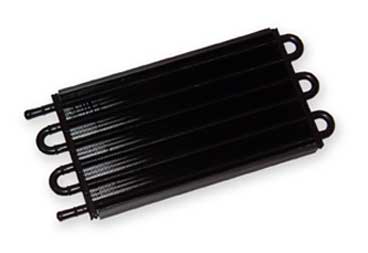 usausausausausaus............aFig. 1 |
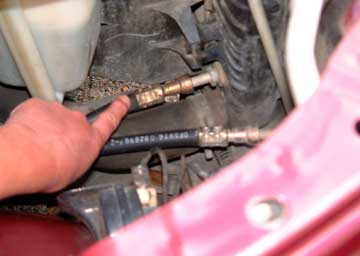 usausausausausausa..........uFig. 2 |
||
The
amount of fluid will ultimately depend upon the size of cooler you decide
to use and the length of the installation pipes. As far as what size
of cooler to use goes there are two things to consider. Firstly, and
probably most important is the amount of cooling you wish to achieve.
Secondly, you will need to consider the amount of space you have available
to fit the cooler in, Fig 3. Our advice on oil cooler
size is to go as large as you possibly can without causing too much
of an obstruction to the regular radiator. However, some manufacturers
will give you guidelines based on gross vehicle weight, GVW, Fig
4. |
|||
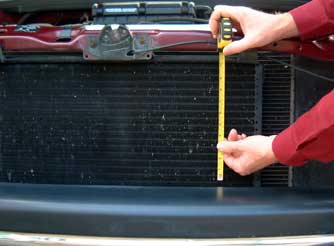 ................................Fig. 3 |
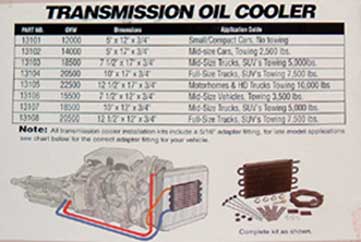 .................................Fig. 4 |
||
Even
though you have measured the area available, it is always worth offering
the cooler up to see if it fits as well as you expected, Fig
5. Most oil cooler kits do come complete with instructions
and a fitting kit. Fig 6. |
|||
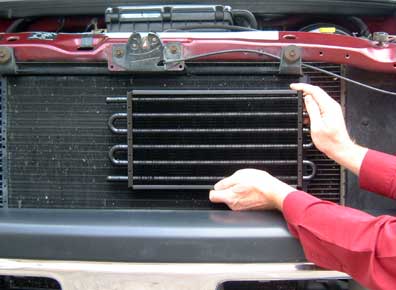 .......................................Fig. 5 |
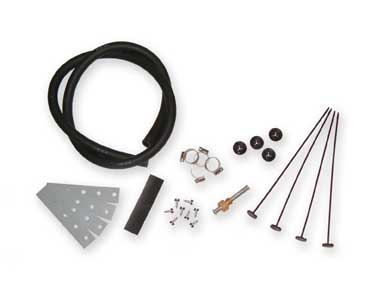 ...................................Fig. 6 |
||
Whilst
on the subject of additional coolers we feel it worth mentioning that
engine oil coolers are also available and work in very much the same
way as the transmission oil coolers, Fig 7. So if you
are running an engine in exceptionally high temperatures it may be well
worth considering cooling the engine oil. Of course keeping the transmission fluid and engine oil cool is almost a waste of time if the engine’s coolant level is allowed to fall. We can’t emphasise enough the importance of checking all fluid levels, on a regular basis. We would take this to include coolant, Fig 8, engine oil, transmission fluid and power steering fluid. This shouldn’t be looked at as a chore, it only takes a few minutes to check and can save hours of sitting at the side of the road and hundreds of pounds in garage bills |
|||
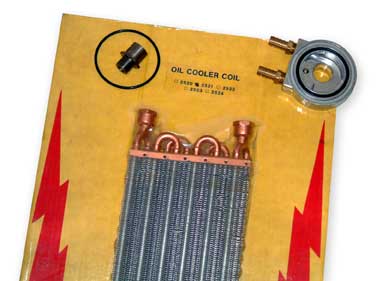 ....................................Fig. 7 |
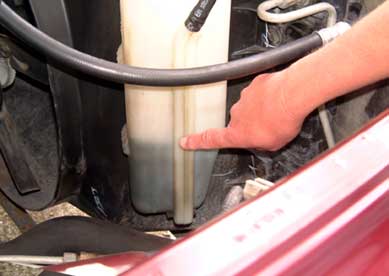 .....................................Fig. 8 |
||
As
mentioned in the last article a low coolant level is probably the most
common cause of over heating and engine failure. A lot of the time the
coolant level is low purely because of neglecting to check and top up
the fluid. However, as we have mentioned in a previous article, a low
coolant level could be a sign of other problems. Remember that just
because you have topped up the coolant it doesn’t mean that the
problem that caused the coolant loss has gone away. Now we did cover antifreeze and coolant in some depth during the last article. However, we would like to cover the subject of coolant colour. Contrary to popular belief the colour of coolant is not just a random factor; there is actually a method behind the madness of coolant. Inorganic Acid Technology (IAT) is the chemical composition for the traditional antifreezes that are green in colour. An IAT can be used with either ethylene glycol or propylene glycol. The normal service life for one of these IAT type antifreezes is two years, as mentioned in the last article this amounts to approximately 20,000 to 30,000 miles. Organic Acid Technology (OAT) was the first long life coolant or extended life coolant introduced in North America in 1994. Previous to this OAT antifreeze had been widely used throughout Europe. OAT is mostly ethylene glycol based and its first dye colours were orange and red. These dye colours are still used by General Motors and Caterpillar. Other colour dyes are being added to the OAT dye list green, pink and blue to name a few. It is highly recommended that these OAT antifreezes not be mixed with other antifreeze technologies. Again as mentioned last time the service life of these OAT’s is approximately five years. IAT and OAT antifreezes are the most popular, however, other technologies are becoming more common. Hybrid Organic Acid Technology (HOAT) is a combination of IAT and OAT with nitrates added. This HOAT particularly well suited to both light and heavy-duty applications. Two manufacturers are currently using HOAT for their vehicles. Daimler-Chrysler’s version is coloured orange and also contains 10% recycled antifreeze. However, Ford’s version is dyed yellow and doesn’t contain any recycled antifreeze. Both of these HOAT products are using the marketing designator of GO-5. Whilst compatible with each other it is not recommended to mix them with either straight IAT or OAT products. HOAT also has a service life of approximately five years. Nitrated Organic Acid Technology (NOAT) is basically an OAT with nitrates added. This makes NOAT suitable for use with light and heavy-duty systems. Both NOAT and HOAT have very similar performance characteristics. Currently we know of no OEM manufacturer using a NOAT product. The service life is again approximately five years. Now hold on a minute, we’re not waffling on just to get an extra page in this rather spiffing publication, but rather to show that antifreeze or coolant can no longer be accurately identified by colour alone. Gone are the days of going into your parts supplier and simply asking for “The red antifreeze please.” We currently know of two orange, two red, a green, a dark green, a yellow, a blue, a blue-green, a pink and a clear coolant or antifreeze. With this much variation, and more being added all the time, it is almost impossible for anyone to know what coolant is in a vehicle by colour alone, Fig 9. Especially if you take in to account the discolouration of the coolant due to it being in an engine for who knows how long. With this in mind if you are unsure flush the system and start again. Hopefully if you have a later date vehicle the handbook should tell which type of coolant you should be using. |
|||
uausa |
 .....................................Fig. 9 |
-------------- | 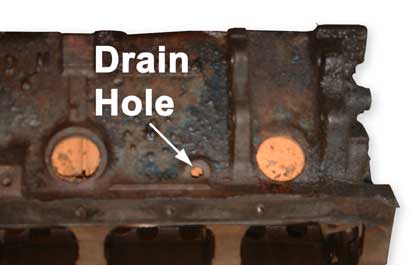 ...................... ...........Fig. 10 |
Discolouration
of the coolant is usually caused by small particles suspended in the
coolant. It is these small particles that can build up and lead to the
blockages that we mentioned in the last article. The easiest way to
deal with this is to flush the cooling system. There are probably as
many different ideas of how to flush a system as there are people prepared
to do it. At the same time there are numerous ‘flushing’
products available which are supposed to help dislodge debris from the
engine and radiators waterways. We have seen some of these flushing
agents work with varying degrees of success. All we will say is if you
choose to use a flushing agent then follow the instructions to the letter.
The easiest way to flush the engine has to be with a hosepipe, Simply
remove the engine drain plug, Fig 10, and allow the
engine to drain completely, taking great care to dispose of the old
coolant correctly. With the engine drained either remove the radiator
cap or disconnect the top hose. The insert a hose into the radiator
and turn it on, Fig 11. After a few seconds you should
see water coming from the engines drain hole. This water should be carrying
with it loose debris from the waterways and may appear to be a rusty
colour Fig 12. |
|||
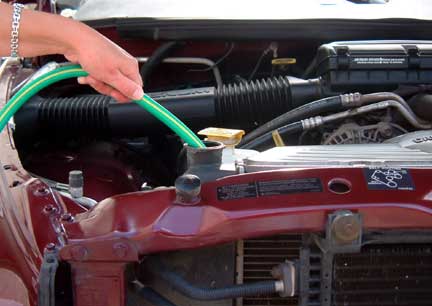 ........................................Fig. 11 |
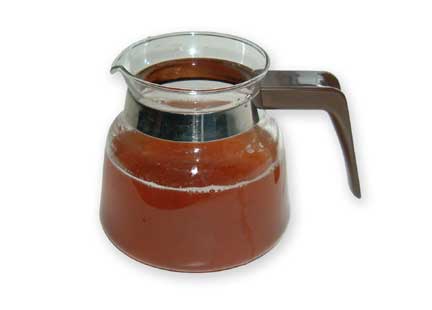 ....................................Fig. 12 |
||
| Run
the hose until the water runs clear and the turn it off and allow the
engine to completely drain. Replace the drain plug and top up the cooling
system with the correct amount of coolant and water. This method may
not clear all the debris from the system but it certainly beats leaving
what debris there is to build up and cause a catastrophic system failure.
A poorly tuned engine. 2. If a part on your vehicle
fails always replace it with the correct part or further failures may
occur. |
|||